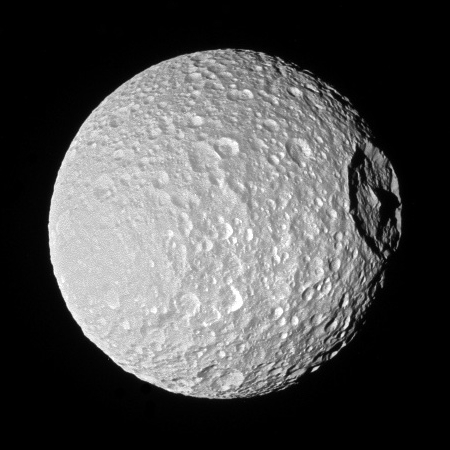Herschel Crater on Mimas

Cool image time! The photo on the right was taken by Cassini on October 22, 2016 when the spacecraft was about 115,000 miles away and has a resolution of about 3,300 feet per pixel. It highlights well Mimas’ most distinctive feature, its single gigantic crater, which also makes the tiny moon of Saturn one of the more distinctive planetary bodies in the entire solar system.
Named after the icy moon’s discoverer, astronomer William Herschel, the crater stretches 86 miles (139 kilometers) wide — almost one-third of the diameter of Mimas (246 miles or 396 kilometers) itself.
Large impact craters often have peaks in their center — see Tethys’ large crater Odysseus in The Crown of Tethys. Herschel’s peak stands nearly as tall as Mount Everest on Earth.
The mystery here is how did Mimas survive such an impact. One would think that the moon would be been split apart by the collision, and that it didn’t suggests the material involved was soft enough to absorb the dynamic forces, and that the speed of the impact was slow enough to reduce those forces overall.

Cool image time! The photo on the right was taken by Cassini on October 22, 2016 when the spacecraft was about 115,000 miles away and has a resolution of about 3,300 feet per pixel. It highlights well Mimas’ most distinctive feature, its single gigantic crater, which also makes the tiny moon of Saturn one of the more distinctive planetary bodies in the entire solar system.
Named after the icy moon’s discoverer, astronomer William Herschel, the crater stretches 86 miles (139 kilometers) wide — almost one-third of the diameter of Mimas (246 miles or 396 kilometers) itself.
Large impact craters often have peaks in their center — see Tethys’ large crater Odysseus in The Crown of Tethys. Herschel’s peak stands nearly as tall as Mount Everest on Earth.
The mystery here is how did Mimas survive such an impact. One would think that the moon would be been split apart by the collision, and that it didn’t suggests the material involved was soft enough to absorb the dynamic forces, and that the speed of the impact was slow enough to reduce those forces overall.
